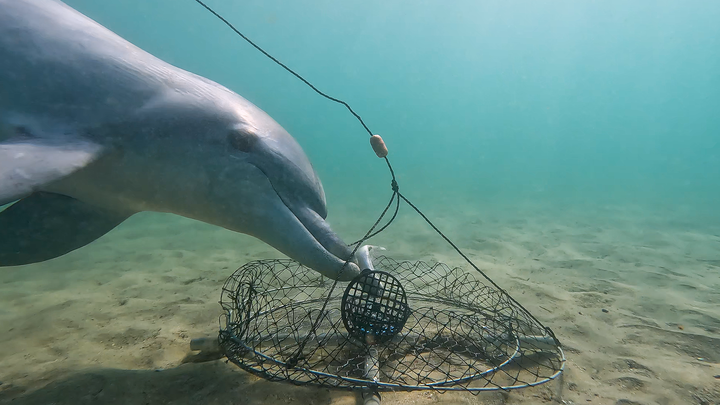Watch dolphins raid crab pots off Australia in never-before-seen footage
Dolphins in Koombana Bay, Western Australia, have learned how to raid crab pots being used for bait and remove the hooks, footage has revealed.
Dolphins have learned how to outsmart crab fishers by stealing the bait from their pots — and new footage has captured the unique behavior for the first time.
The bottlenose dolphins watch as the crab fishers load their nets with fish and drop them into the ocean off Koombana Bay, Western Australia. Then, the animals nose their way into the nets and pull the bait off the hooks in the crab pots.
The crab fishers tried putting the bait underneath the pots or in bait boxes to deter the thieves, but the dolphins quickly learned how to tip them over or open the boxes.
Wildlife conservationist Rodney Peterson first spotted the behavior two years ago and was concerned that the dolphins would become tangled in the nets or eat unhealthy food.

He approached the Dolphin Discovery Centre in the city of Bunbury, which set up five cameras to film the animals in action.
Related: 11 ways orcas show their terrifying intelligence
"Dolphins are very smart, brilliant observers and forage for food all the time. Often, when they see an opportunity they will go for it, especially the mothers with calves," filmmaker Axel Grossmann, who volunteers at the Dolphin Discovery Centre alongside wildlife conservationists, told Live Science in an email.
Get the world’s most fascinating discoveries delivered straight to your inbox.
The dolphins opened the pots in different ways. "The most basic version is that the dolphin grabs the bait which sits on a hook or metal pin inside the crab pot. So essentially the dolphins pull the fish off the pin or break it down into edible pieces," Grossmann said.
To deter the mammals, some of the fishers placed the bait underneath the crab pots, which meant the dolphins had to use more sophisticated techniques to get it. "They learned to turn crab pots around using their rostrum (jaws) and bodies, so they could access the bait more easily," Grossmann said.

The dolphins even opened bait boxes — plastic containers used to hold the bait. "Some locksmith dolphins have learned to open the latch with their rostrum or teeth — and once the lid of the box opens, they grab the fish," Grossmann said.
Because the conservationists worried that the dolphins would become entangled or injured, they developed a new, dolphin-safe solution.
"We and some crab fishermen developed a mesh bait pouch with a metal hook that kept the bait closed in tight," Grossmann said. "The dolphins learned that it wasn't accessible, so they swam off. It means we get healthier dolphins and happier crab fishermen."
Dolphins steal food for different reasons, Grossmann said.
"If they are hungry, they might put more effort into working out how to forage for additional food sources like crab bait, especially in an area that is highly frequented by humans. Essentially the dolphin sees humans putting food on a plate in their backyard," he said.
But not all dolphins are doing it, so there may be other reasons why the animals are going after the crab bait.
"We believe it is a mixture of interest, an easy way to get a fish, learned adaptive behavior and maybe even a bit of fun," Grossmann said.

Lydia Smith is a health and science journalist who works for U.K. and U.S. publications. She is studying for an MSc in psychology at the University of Glasgow and has an MA in English literature from King's College London.


